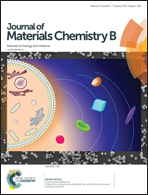Histidine-enriched multifunctional peptide vectors with enhanced cellular uptake and endosomal escape for gene delivery†
Abstract
Peptide vectors offer a promising gene delivery approach because of their biocompatibility and ease of functionalization. This article describes the design and evaluation of a series of multifunctional peptides and their gene delivery abilities. The peptides were composed of a cell-penetrating segment, stearyl moiety, cationic amphiphilic α-helical segment, and cysteine and histidine residues. The proton sponge effect of histidine residues at low pH and the α-helical conformation should improve endosomal escape. Inclusion of D-type amino acids should improve proteolytic stability. The conformation, particle size and zeta potential of peptide/DNA complexes were characterized by circular dichroism and dynamic light scattering. Gene transfection efficiency was investigated by fluorescence-activated cell sorting and confocal microscopy. Transfection efficiencies of the designed peptide vectors were better than those of C18-C(LLKK)3C-TAT and Lipo2000. D-Type peptide C18-c(llhh)3c-tat showed three times higher transfection efficiency at N/P ratios of 6 and 8 than Lipo2000 in NIH-3T3 and 293T cells. All peptides showed lower cytotoxicity than Lipo2000 in NIH-3T3 and 293T cells. In the presence of trypsin or serum in vitro, D-type peptides showed better stability than L-type peptides. Overall, the designed histidine-enriched multifunctional peptide gene vectors promoted cellular uptake, endosomal escape and gene transfection.


 Please wait while we load your content...
Please wait while we load your content...